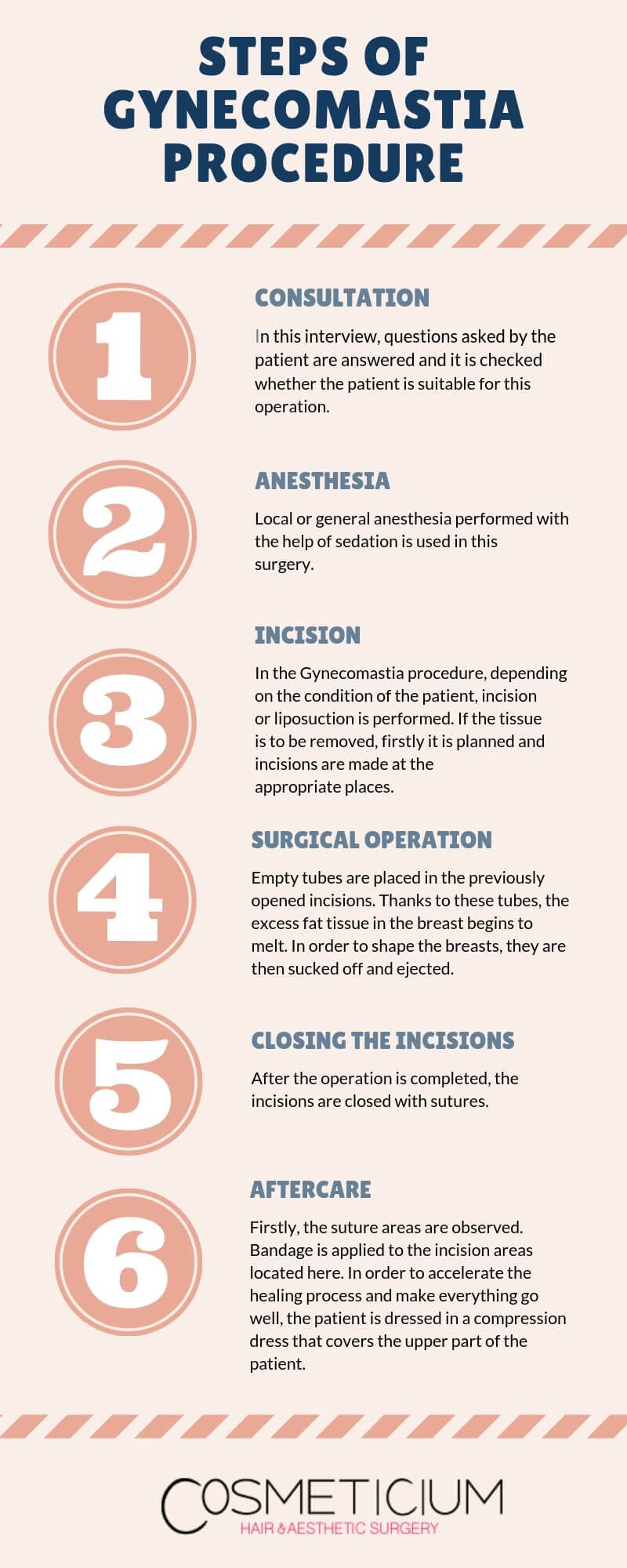One of the abnormalities in the male body is that the breasts are larger than normal. Gynecomastia is the name given to the breast reduction operation in men. With this surgery, the breasts of men are made compatible with the size of the ribcage. The basis of this process is the removal of excess tissues and skins. Gynecomastia, which is a surgical operation, is a procedure preferred by men who want to have a normal appearance. The success rate of this procedure is quite high.
What is Gynecomastia and how is it done? We have compiled the answers to the most frequently asked questions about the steps, risks and advantages of Gynecomastia operation.
Table of Contents
Steps of Gynecomastia Procedure
To understand the main causes of Gynecomastia, we must first understand the hormones. There is a significant difference between the levels of some of the hormones secreted in men and women. While testosterone is more secreted in men, estrogen is more secreted in women and this helps people gain gender characteristics. One of the functions of estrogen is to control the size of the breast, and when it is secreted more than normal in men, an abnormal appearance occurs in the breast. Gynecomastia surgery is also a surgical procedure for the normalization of breasts. Gynecomastia surgery has a number of stages in itself. These stages are as follows:
1. Consultation
The patient has an interview with the doctor. In this interview, questions asked by the patient are answered and it is checked whether the patient is suitable for this operation. In addition, the patient is asked how he/she wants to look and detailed information is given about both the operation and the post-operative period.
2. Anesthesia
Another stage of the Gynecomastia procedure is anesthesia. Local or general anesthesia performed with the help of sedation is used in this surgery. If general anesthesia is to be preferred, the patient should be consulted with the anesthesiologist before the operation to determine if it is appropriate. Depending on the condition of the patient, one of these anesthesia methods is administered, thus avoiding any pain during Gynecomastia surgery.
3. Incision
In the Gynecomastia procedure, depending on the condition of the patient, incision or liposuction is performed. If the tissue is to be removed, firstly it is planned and incisions are made at the appropriate places. If liposuction is to be performed, incisions are made to insert the cannulas required for this procedure. The incisions for the cannulas are relatively small. Smaller incisions result in a shorter recovery time. However, if surgical procedures are to be performed on the brown ring called areola, the incisions have to be slightly larger.
You May Also Like: Which Questions Should I Ask My Doctor About Gynecomastia?
4. Surgical Procedure Technique
The technique to be used in Gynecomastia surgery highly affects how long the procedure will last and how long the recovery will be. If the liposuction technique is to be used in the operation, empty tubes are placed in the previously opened incisions. Thanks to these tubes, the excess fat tissue in the breast begins to melt. In order to shape the breasts, they are then sucked off and ejected.
In another method, excess fat and other tissues are removed out of the opened incisions. Then, the position of the areola and the nipples is readjusted and they are proportioned. Depending on the individual’s condition, sometimes liposuction and sometimes removal may be preferred. In some cases, both methods are used at the same time.
5. Closing the incisions
After the operation is completed, the incisions are closed with sutures. Before this process, drainage tubes can be used to drain the blood and other liquids inside. This reduces the risk of swelling and infection.
6. Care
After Gynecomastia surgery, care is extremely important. Firstly, the suture areas are observed. Bandage is applied to the incision areas located here. In order to accelerate the healing process and make everything go well, the patient is dressed in a compression dress that covers the upper part of the patient. Patients need to be hospitalized in these surgeries, but in some cases it is possible to perform surgery even in the outpatient setting. Also during the recovery phase, these drainage pipes are removed 1 week or 10 days after the operation.

You May Also Like: What Are the Main Causes of Gynecomastia?
Frequently Asked Questions in Gynecomastia Procedure
- Is Gynecomastia a painful procedure?
Gynecomastia surgery is performed under local or general anesthesia. Therefore, you will not have any pain during surgery. However, you may experience pain after the operation. You can use painkillers prescribed by your doctor for this.
- Will there be any scar after Gynecomastia procedure?
For Gynecomastia, incisions are made in the breast area. But they are extremely small and cannot be noticed from the outside. Depending on the ability of the surgeon performing the procedure, it is even possible to completely conceal them.
- Is there any loss of sensation in the nipples after Gynecomastia surgery?
Incisions made during Gynecomastia surgery cause partial loss of sensation in some patients, while in some patients it does not cause any problems. Therefore, the expertise of the physician performing the operation directly affects the answer to this question. This problem can be prevented by choosing a qualified and experienced doctor in the field.
- What are the points to be considered while getting prepared for the operation?
No special preparation is required before the operation. However, you should tell your doctor about the medications you use, especially medications that affect clotting. In addition, it is sufficient to do what is requested by the doctor.
- Is the change in breasts immediately noticeable?
As in any surgical operation, Gynecomastia may also cause a number of conditions such as swelling, flushing and bruising. Therefore, it is often not possible to see the effect of the operation immediately. A minimum period of 3-6 months is required for the exact effect of the procedure.
- Will the check-ups continue after surgery?
The check-ups will continue after the Gynecomastia procedure. However, these are routine and when the findings are normal; the number of these check-ups is limited to 2-3. No further control is required.
You Can Check Out This Page to Get More Information About Gynecomastia Surgery in Turkey

